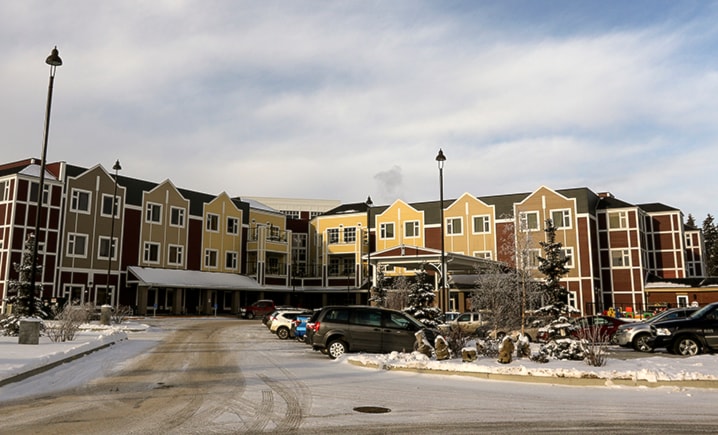Long-term care facilities in Central Alberta have some work to do to reduce the use of restraints, potentially inappropriate use of antipsychotics, and the number of residents experiencing worsening pain according to new data.
This week Canadian Institute for Health Information showed daily physical restraints were used on 19 per cent of residents in the Central Zone compared to 8.6 per cent across Alberta in 2014-15.
CIHI says restraints are sometimes used to manage behaviours or prevent falls. But there are many potential physical and psychological risks associated with applying physical restraints to older adults, and such use raises concerns about safety and quality of care.
In Central Zone, 28.9 per cent of residents were taking antipsychotic drugs without a diagnosis of psychosis compared to 21.1 per cent provincially.
CIHI says these drugs are sometimes used to manage behaviours in residents who have dementia. Careful monitoring is required as such use raises concerns about safety and quality of care.
In Central Zone, 18.5 per cent of residents had worsening pain compared to 13.2 per cent across Alberta. CIHI says worsening pain can be related to a number of issues, including medication complications and/or improper management of medication. Careful monitoring of changes in pain can help identify appropriate treatment. Worsened pain raises concerns about a resident’s health status and the quality of care received.
Dr. James Silvius, provincial medical director for seniors health with Alberta Health Services, said in general he was reasonably pleased with the data results, but there is some work to do, like reducing use of restraints in Central Zone.
“It declined for three years and then it went up in Central Zone. I’m not entirely sure why that is. We know there are certain sites that are a fair amount higher than others. When you think about the size of many of these facilities, small changes in the number of people can really skew the data unfortunately,” Silvius said on Friday.
In the Red Deer region, the use of restraints was highest at Rimbey Hospital and Care Centre at 43 per cent and lowest at Extendicare Michener Hill in Red Deer at 0.1 per cent.
He said the potentially inappropriate use of antipsychotics has actually dropped significantly in Central Zone from 34.7 per cent last year to 28.9 as AHS works to reduce the use of antipsychotics.
“We recognize that this was an issue within AHS. We started to work on it. Central Zone has further to go than some of the others and we’re making good progress.”
Residents taking antipsychotic drugs without a diagnosis of psychosis was highest at Olds Hospital and Care Centre at 37.5 per cent and lowest at Extendicare Michener Hill in Red Deer at 20.2 per cent.
When it comes to worsening pain, there are some sites in the zone that are doing better than others.
“One of the sites that have done very well made recognition and management of pain a specific focus of activity last year and their results are way better than just about anyone else’s which suggests there’s some best practice sitting in Central Zone which we need to look at replicating.”
He said that site was Extendicare Michener Hill.
Residents with worsening pain was highest at Bethany Sylvan Lake at 31.5 per cent and lowest at Extendicare Michener Hill at 4.9 per cent.
Worsening pressure ulcers was particularly high at Consort Hospital and Care Centre where 17.4 per cent of patients had worsening ulcers. The provincial rate was 3.1 per cent.
Pressure ulcers can happen when a resident sits or lies in the same position for a long period of time.
Immobility may be due to many physical and psychological factors, neurological diseases like Alzheimer’s and improper nutrition or hydration. CIHI says careful monitoring is required to ensure good quality of care.
Silvius said since the Consort facility only has 15 long-term care beds, one resident developing a pressure sore or coming in with a sore will have a big impact on their statistics. That’s what he suspects happened.
Kira Leeb, CIHI director of health system performance, said in previous years, the percentage of worsening pressure ulcers in Consort was on par with the regional and provincial rate.
“It is only in this last year that there’s been a spike. Certainly I would be much more concerned if the trend was ongoing, if it had gone up year after year. That would suggest people aren’t on top of it,” Leeb said.
She said by reporting on a variety of health care indicators CIHI provides a balanced perspective.
“It’s nice to have that picture. A lot of times what we see is hospitals and long-term care facilities perform well on some indicators and poor on others,” Leeb said.
She said if a facility ranked high on several of the indicators that would be odd.
People pay particular attention to potentially inappropriate use of antipsychotics, restraint use, and falls among seniors.
“Those are really the ones we have many more conversations about. This is really what this information is meant to do, to drive conversation.”
This is only the second time CIHI has publicly released data on the long-term care sector. The first time data came out was in June.
In Central Alberta, data comes from 39 long-term care facilities. Across the province, there are 168 facilities.
National data was calculated from about 57 per cent of long-term care facilities.
Leeb said people are visiting the CIHI interactive website to find out how facilities are performing.
“The most important thing for us is really that people have a sense, because they pay for much of the health care system, to know how it’s performing.”
For more information visit www.cihi.ca.
szielinski@www.reddeeradvocate.com
